So I wrote a script that would show monthly premium. Say if you want to view the total premium up to November, you can pass through a parameter in in SSRS to pick 1/1/2016 - 11/30/2016. This would only show the data up until november, hoever, I would like to show it up until december even if there are no records there. How do I go about doing this in SQL? Here is my script so far:
SELECT lc.[Date]
,lc.Carrier
,lc.[Direct Ceded Written Premium]
,cast(cast(year(lc.[date]) as varchar(4)) + '-' + cast(month(lc.[date]) as varchar(2)) + '-01' as date) as [begofmonth]
from
(
SELECT
CASE
WHEN pd.TransactionEffDate < pd.TransactionDate THEN cast(pd.TransactionDate as DATE)
WHEN pd.TransactionEffDate < pd.EffectiveDate THEN cast(pd.EffectiveDate as DATE)
ELSE cast(pd.TransactionEffDate as date)
END AS [Date]
,CASE WHEN LEFT(PD.POLICYNUM, 3) = 'ORV'
THEN 'Palomar Value Select OR'
WHEN LEFT(PD.POLICYNUM, 3) = 'VSE'
THEN 'Palomar Value Select CA'
WHEN LEFT(PD.POLICYNUM, 3) = 'WAV'
THEN 'Palomar Value Select WA'
ELSE 'Palomar' END AS [Carrier]
,ISNULL(SUM(pd.WrittenPremium), 0) AS [Direct Ceded Written Premium]
FROM premdetail pd
JOIN transactionpremium tp ON pd.systemid = tp.systemid
AND pd.transactionpremiumid = tp.id
JOIN transactionhistory th ON tp.systemid = th.systemid
AND tp.cmmcontainer = th.cmmcontainer
AND tp.parentid = th.id
JOIN basicpolicy bp ON th.systemid = bp.systemid
AND th.cmmcontainer = bp.cmmcontainer
AND th.parentid = bp.id
WHERE
(CASE
WHEN pd.TransactionEffDate < pd.TransactionDate THEN pd.TransactionDate
WHEN pd.TransactionEffDate < pd.EffectiveDate THEN pd.EffectiveDate
ELSE pd.TransactionEffDate
END) > = CAST(@StartDate AS DATE)
AND (CASE
WHEN pd.TransactionEffDate < pd.TransactionDate THEN pd.TransactionDate
WHEN pd.TransactionEffDate < pd.EffectiveDate THEN pd.EffectiveDate
ELSE pd.TransactionEffDate
END) < CAST(@EndDate + 1 AS DATE)
AND (bp.carriercd = @ResEQCarrierCd
OR @ResEQCarrierCd = 'All')
GROUP BY
CASE
WHEN pd.TransactionEffDate < pd.TransactionDate THEN cast(pd.TransactionDate as DATE)
WHEN pd.TransactionEffDate < pd.EffectiveDate THEN cast(pd.EffectiveDate as DATE)
ELSE cast(pd.TransactionEffDate as date)
END
,CONVERT(VARCHAR, pd.EffectiveDate, 101)
,CONVERT(VARCHAR, pd.ExpirationDate, 101)
,CASE
WHEN LEFT(PD.POLICYNUM, 3) = 'ORV'
THEN 'Palomar Value Select OR'
WHEN LEFT(PD.POLICYNUM, 3) = 'VSE'
THEN 'Palomar Value Select CA'
WHEN LEFT(PD.POLICYNUM, 3) = 'WAV'
THEN 'Palomar Value Select WA'
ELSE 'Palomar'
END
,CASE
WHEN pd.TransactionCode = 'EN' THEN CONVERT(VARCHAR, th.TransactionEffectiveDt, 101)
ELSE ''
END
,CONVERT(VARCHAR, DATEADD(ms, -3, DATEADD(mm, DATEDIFF(m, 0, th.transactiondt) + 1, 0)), 101)
,CASE
WHEN pd.TransactionEffDate < CAST(CONVERT(VARCHAR, pd.TransactionDate, 101) AS SMALLDATETIME) THEN CONVERT(VARCHAR, pd.TransactionDate, 101)
WHEN pd.TransactionEffDate < pd.EffectiveDate THEN CONVERT(VARCHAR, pd.EffectiveDate, 101)
ELSE CONVERT(VARCHAR, pd.TransactionEffDate, 101)
END
) lc
ORDER BY lc.[Date], lc.[Carrier], lc.[Direct Ceded Written Premium]
With the parameter that I have, it would only show up until November. However, I would like it to show the whole year, up to December at in this case, even if there are no data there since I didn't pick the enddate variable to be december. I attached an example screenshot of what it should look like when exported to excel.
